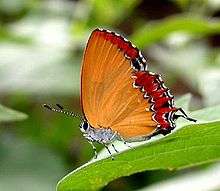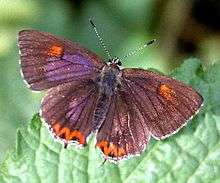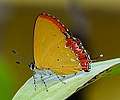Heliophorus epicles
Heliophorus epicles, the purple sapphire,is a species of lycaenid or blue butterfly found in Asia.[1] The species was first described by Jean Baptiste Godart in 1823.
| Purple sapphire | |
|---|---|
 | |
| From Jairampur, Arunachal Pradesh, India | |
| Scientific classification | |
| Kingdom: | Animalia |
| Phylum: | Arthropoda |
| Class: | Insecta |
| Order: | Lepidoptera |
| Family: | Lycaenidae |
| Genus: | Heliophorus |
| Species: | H. epicles |
| Binomial name | |
| Heliophorus epicles Godart 1823 | |
Subspecies
The subspecies of Heliophorus epicles are:[2][3]
- Heliophorus epicles epicles Fruhstorfer, 1918 – western Java
- Heliophorus epicles hilima Fruhstorfer, 1912 – eastern Java
- Heliophorus epicles latilimbata Fruhstorfer, 1908 – Nepal, Sikkim, Bhutan, Assam, Myanmar, Andamans, Thailand, Laos, Vietnam, southern Yunnan
- Heliophorus epicles tweediei Eliot, 1963 – Peninsular Malaya
- Heliophorus epicles sumatrensis Fruhstorfer, 1908 – Sumatra
- Heliophorus epicles phoenicoparyphus Holland, 1887 – Hainan
Distribution
In India, this butterfly can only be traced in the Himalayas at 2000–7000 ft (600–2100 m). Apart from that they can be found from Kumaon in the Himalayas to southern Myanmar. They mainly inhabit in dense forest region.[4][5][6]
Gallery
 In Uttar Pradesh, India
In Uttar Pradesh, India In Himachal Pradesh, India
In Himachal Pradesh, India Male on left, female right
Male on left, female right_in_Samsing%2C_Duars%2C_West_Bengal_W_IMG_6320.jpg)
_in_Samsing%2C_Duars%2C_West_Bengal_W_IMG_6202.jpg) Male at Samsing
Male at Samsing_in_Samsing%2C_Duars%2C_West_Bengal_W_IMG_6199.jpg) Male at Samsing
Male at Samsing_in_Samsing%2C_Duars%2C_West_Bengal_W_IMG_6169.jpg) Male at Samsing
Male at Samsing_in_Samsing%2C_Duars%2C_West_Bengal_W_IMG_6002.jpg) Male at Samsing
Male at Samsing-_Female_at_Samsing%2C_Duars%2C_WB_W_IMG_6189.jpg) Female at Samsing
Female at Samsing-_Female_at_Samsing%2C_Duars%2C_WB_W_IMG_6182.jpg) Female at Samsing
Female at Samsing Cameron Highlands, Malaysia
Cameron Highlands, Malaysia Cameron Highlands, Malaysia
Cameron Highlands, Malaysia
gollark: No. 96 electromagnets, 200RF/t each...
gollark: It might be. I may have miscounted somewhere.
gollark: How much power does it produce?
gollark: That's excluding electromagnets, right? I think those are 24kRF/t, so this might be hard.
gollark: Total RF and RF/t, that is.
References
- R.K., Varshney; Smetacek, Peter (2015). A Synoptic Catalogue of the Butterflies of India. New Delhi: Butterfly Research Centre, Bhimtal & Indinov Publishing, New Delhi. doi:10.13140/RG.2.1.3966.2164. ISBN 978-81-929826-4-9.
- Savela, Markku. "Heliophorus epicles (Godart, [1824])". Lepidoptera and Some Other Life Forms. Retrieved 2 October 2018.
- "Heliophorus epicles Godart, 1823 – Purple Sapphire". Retrieved 28 March 2017.
- Pratap Singh, Arun (2011). Butterflies of India (1st ed.). Uttar Pradesh: Om Books International. p. 77. ISBN 978-93-80069-60-9.
- Mahapatra, A.K. "A preliminary study on diversity of butterflies (Lepidoptera: Macrolepidoptera) in Regional Institute of Education campus, Bhubaneswar, Odisha, India" (PDF). Journal of Entomology and Zoology Studies. 4 (2): 489–496. ISSN 2320-7078. Retrieved 16 February 2017.
- Pal, S.; et al. "Holistic Survey On Butterfly Diversity at Two Selected Regions of the Northern Parts of Bengal, India". International Research Journal of Natural and Applied Sciences. 2 (4): 42–57. ISSN 2349-4077. Retrieved 16 February 2017.
- Evans, W.H. (1932). The Identification of Indian Butterflies (2nd ed.). Mumbai, India: Bombay Natural History Society.
- Gaonkar, Harish (1996). Butterflies of the Western Ghats, India (including Sri Lanka) - A Biodiversity Assessment of a Threatened Mountain System. Bangalore, India: Centre for Ecological Sciences.
- Gay, Thomas; Kehimkar, Isaac David; Punetha, Jagdish Chandra (1992). Common Butterflies of India. Nature Guides. Bombay, India: World Wide Fund for Nature-India by Oxford University Press. ISBN 978-0195631647.
- Haribal, Meena (1992). The Butterflies of Sikkim Himalaya and Their Natural History. Gangtok, Sikkim, India: Sikkim Nature Conservation Foundation.
- Kunte, Krushnamegh (2000). Butterflies of Peninsular India. India, A Lifescape. Hyderabad, India: Universities Press. ISBN 978-8173713545.
- Wynter-Blyth, Mark Alexander (1957). Butterflies of the Indian Region. Bombay, India: Bombay Natural History Society. ISBN 978-8170192329.
| Wikimedia Commons has media related to Heliophorus epicles. |
This article is issued from Wikipedia. The text is licensed under Creative Commons - Attribution - Sharealike. Additional terms may apply for the media files.